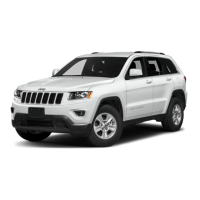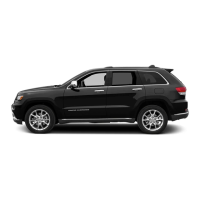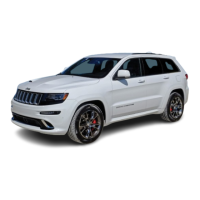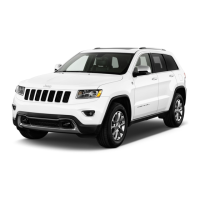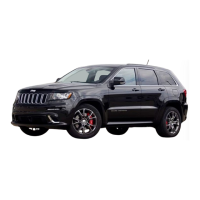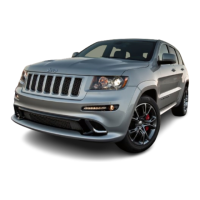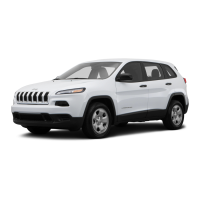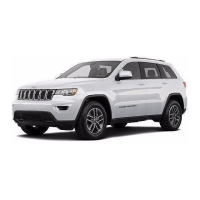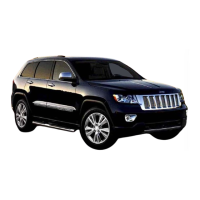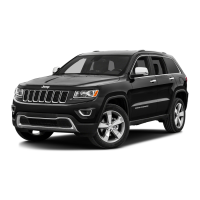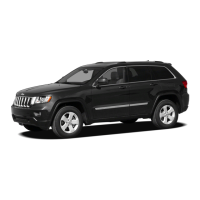
Do you have a question about the Jeep 2014 Grand Cherokee SRT8 and is the answer not in the manual?
| Brand | Jeep |
|---|---|
| Model | 2014 Grand Cherokee SRT8 |
| Category | Automobile |
| Language | English |
Warning about the higher rollover rate of utility vehicles and safe driving practices.
Guidance on navigating the owner's manual using the table of contents and index.
Introduces the keyless ignition system, consisting of a Key Fob and Keyless Ignition Node (KIN).
Explains the Sentry Key Immobilizer System that prevents unauthorized vehicle operation by disabling the engine.
Information on obtaining and programming replacement Key Fobs, including the Personal Identification Number (PIN).
Describes the Vehicle Security Alarm system that monitors doors, liftgate, and ignition for unauthorized operation.
Details on locking/unlocking doors, opening the liftgate, and activating the Panic Alarm from a distance.
Instructions on using the RKE transmitter to unlock the driver's door or all doors and liftgate.
Instructions on using the RKE transmitter to lock all doors and the liftgate, with turn signal flash and horn chirp confirmation.
Details power window controls on the driver's door trim panel and their operation.
Never leave children unattended with power windows; entrapment can cause serious injury or death.
Describes the auto-down feature for driver and front passenger window switches.
How to use the auto-up feature with anti-pinch protection for driver and front passenger windows.
Details on unlocking and entering the liftgate using passive entry.
How to open and close the power liftgate using various methods (handle, RKE, console).
Details on the vehicle's restraint systems, including seat belts, airbags, and head restraints.
Explains the lap/shoulder belt system and the retractor's ability to lock during sudden stops or collisions.
Explains how the ALR mode works for securing child seats and how to engage/disengage it.
Passive, deployable head restraints designed to minimize head gap during rear impacts.
Steps to reset head restraints after they have been triggered or moved forward.
Feature to remind driver and front passenger to fasten seat belts, with audio and visual notifications.
Details advanced front airbags, knee airbags, and knee bolsters as supplements to seat belts.
Explains multistage airbags and how they adjust output based on collision severity and seat position.
Provides enhanced protection during side impacts; SAB is marked with an airbag label on the seat.
Offers side-impact and rollover protection for outboard occupants, deploying downward.
Sensors that aid the ORC in determining appropriate response to impact events.
Automatically cuts fuel, flashes hazard lights, turns on interior lights, and unlocks doors after an impact.
Warnings against modifying the airbag system and the dangers of attempting self-repair.
Explains the function of the Air Bag Warning Light and when to seek service.
Vehicle equipped with an EDR to record crash data for analysis.
Emphasizes that all occupants, especially children, need proper restraint systems as required by law.
A 5-step test to determine if a child can use the vehicle's seat belt alone.
Table showing attachment methods for child restraints (LATCH, Seat Belt Only, etc.) based on restraint type and weight.
Explains the LATCH system, its anchor points, and its use for installing LATCH-equipped child seats.
Diagram showing LATCH anchor locations and symbols.
Details on weight limits, using LATCH with seat belts, and center position installation.
Instructions on how to stow unused ALR seat belts when using the LATCH system.
Explains seat belts with ALR or cinching latch plates for securing child restraints.
Step-by-step guide for installing a child restraint using the ALR seat belt system.
How to locate and use the top tether anchorage for child restraints.
Specific instructions for routing the tether strap for the center seating position.
Airbags can harm pets; unrestrained pets can injure passengers or be injured in a collision.
Guidance on proper break-in procedures for the drivetrain to ensure optimal performance and durability.
Includes transporting passengers in cargo areas, exhaust gas safety, and general warnings.
Information on the dangers of carbon monoxide (CO) in exhaust gases and safety tips.
Checks for seat belts, including inspection for damage and proper replacement.
Explains the function of the Air Bag Warning Light and when to seek service.
Warnings about ensuring floor mats do not obstruct pedals or impair vehicle control.
Checks for tires (wear, objects, cuts, pressure), lights (brake, exterior, signals), and door latches.
Checking for positive closing, latching, and locking of doors.
Checking under the vehicle for fuel, coolant, oil, or other fluid leaks.
Information on inside day/night mirrors, automatic dimming mirrors, and outside mirrors.
Explains automatic adjustment for headlight glare and how to turn the feature on/off via Uconnect®.
How to use the ASSIST button for roadside assistance or customer care.
Guidance on adjusting outside mirrors for maximum benefit and clear lane traffic view.
Electrical folding and unfolding of mirrors using a switch located between L and R mirror controls.
Operation of power mirror controls, including mirror selection and directional adjustment.
Outside mirrors automatically adjust for glare from vehicles behind, controlled by the inside mirror.
Mirrors are heated to melt frost or ice, activated with the rear window defroster.
Automatic outside mirror positioning in REVERSE to aid driver's view of the ground rearward.
How to access illuminated vanity mirrors by flipping down sun visors.
Allows additional flexibility in positioning the sun visor to block the sun.
Uses radar sensors to detect vehicles in blind spot zones and alerts the driver.
Aids driver when backing out of parking spaces by monitoring oncoming vehicles.
Describes selectable modes of operation for BSM/RCP via EVIC or Uconnect® system.
Provides visual alert in mirrors based on detected objects, with audible alerts and radio muting if requested.
Seats are part of the Occupant Restraint System; discusses power seats if equipped.
Information on eight-way power driver and front passenger seats and their switches.
How to adjust seat position forward or rearward using the seat switch.
How to adjust the seatback angle forward or rearward using the seatback switch.
How to fold the seatback to a flat load-floor position.
Front and rear seats may have heaters; controls are in the Uconnect® system screen.
How to operate front heated seats independently using Uconnect® system controls.
Outboard rear seats equipped with heaters, operated independently by switches on the center console.
How to operate front ventilated seats using Uconnect® system controls for cooling.
Designed to reduce injury risk by restricting head movement in rear impacts; adjust properly.
Passive, deployable head restraints that extend forward to minimize head gap during rear impacts.
Rear outboard head restraints are not adjustable; they fold forward automatically with the rear seat.
Allows lowering either side of the rear seat for cargo space while maintaining some seating.
Allows storing up to two memory profiles for seat, mirror, and steering column positions.
Steps to create a new memory profile for seat, mirror, steering column, and radio presets.
Programming RKE transmitters to recall memory profiles by pressing the UNLOCK button.
How to recall memory positions using the memory switch or RKE transmitter.
Automatic driver seat positioning for easier entry and exit.
Steps to release the hood latches to open the hood.
Headlight switch operation and its control over headlights, parking lights, etc.
System automatically turns headlights on/off based on ambient light; includes headlight delay.
System uses a camera to automatically switch between high and low beams based on light and approaching vehicles.
Lights that come on when the engine is running and transmission is not in PARK.
Adjusts headlight beam height automatically based on vehicle pitch changes.
System swivels headlight beam horizontally for improved steering-based illumination.
Headlights stay on for a programmable duration after exiting the vehicle.
How to turn on parking and instrument panel lights by rotating the headlight switch.
How to turn fog lights on by rotating the headlight switch and pushing the rotary control.
Operation of courtesy and dome lights, including dimmer control and "Party" mode.
How to turn on map/reading lights in the overhead console via switches or RKE unlock button.
Location and function of the multifunction lever on the left side of the steering column.
How to operate turn signals and indicators, and troubleshooting for non-flashing or fast flashing lights.
Tapping the lever up or down flashes the turn signal three times for lane changes.
Controls for windshield wipers and washers are on the multifunction lever.
Using intermittent wiper settings with variable delay based on weather conditions.
Using the Mist feature for occasional wiper use; it performs a single wiping cycle.
Senses windshield moisture and automatically activates wipers; sensitivity is adjustable.
Feature allows tilting and telescoping the steering column for driver comfort and visibility.
How to adjust the steering column's tilt and telescope functions using the power lever.
Steering wheel contains a heating element for cold weather comfort, with one temperature setting.
System takes over accelerator operations at speeds over 25 mph (40 km/h).
Steps to activate electronic speed control by pushing the ON/OFF button.
How to set a desired speed using the SET (+) or SET (-) buttons.
How to deactivate speed control using brake pedal, CANCEL button, or ON/OFF button.
How to resume a previously set speed using the RES button.
How to increase or decrease the set speed using SET (+/-) buttons, with notes on override and deceleration.
Increases driving convenience by maintaining distance to preceding vehicles on highways.
Limitations of ACC system, such as not reacting to pedestrians, stationary objects, or complex conditions.
Conditions under which ACC can be activated, and EVIC messages displayed.
How to set a desired ACC speed using SET + button and potential driver override messages.
Conditions that cancel the ACC system, such as brake application or CANCEL switch.
How to turn off the ACC system and clear set speed from memory.
How to resume a previously set speed using the RES button.
How to increase or decrease the set speed using SET +/- buttons, with notes on override and deceleration.
How to set following distance using four bars (longest) to one bar (shortest).
Warning to apply brakes immediately if ACC predicts maximum braking is insufficient.
Provides additional acceleration to assist in passing when the turn signal is used.
EVIC displays current ACC system settings and status.
Warning message and chime indicating temporary system limitation due to visibility or obstructions.
Indicates internal system fault or temporary malfunction limiting ACC functionality.
ACC may have detection issues in certain situations; driver must stay alert and intervene.
ACC may not detect vehicles until they are fully in the lane, requiring driver attentiveness.
FCC requirements for Vehicular Radar Systems.
Mode for cruising at a fixed preset speed without accelerator operation.
System provides warnings and limited braking to help avoid or mitigate potential frontal collisions.
Provides visual and audible indications of distance to obstacles when backing up.
Four sensors in the rear fascia/bumper monitor the area behind the vehicle.
Warning screen displayed if Sound and Display is selected in Uconnect® system.
EVIC displays park assist system status when in REVERSE or DRIVE with detected obstacle.
Chart summarizing audible alerts, arcs, and radio volume reduction based on rear/front distance.
How to enable and disable ParkSense® using the ParkSense® switch.
Messages and chime indicating a faulted condition or required service for the ParkSense® system.
How to clean ParkSense® sensors using water, mild soap, and a soft cloth.
Precautions including keeping sensors clear, avoiding vibrations, and disabling system with tailgates.
Provides visual and audible indications of distance to obstacles when backing up or moving forward.
Details the four rear and six front ParkSense® sensors and their detection ranges.
Warning screen displayed if Sound and Display is selected in Uconnect® system.
EVIC displays park assist system status when in REVERSE or DRIVE with detected obstacle.
Allows viewing rear surroundings on the radio touchscreen display when in REVERSE.
Steps to turn ParkView® Backup Camera ON or OFF via Uconnect® 5.0 system.
Steps to turn ParkView® Backup Camera ON or OFF via Uconnect® 8.4A/8.4AN system.
Location of courtesy/reading lights, sunglass storage, and optional features like HomeLink®.
How to turn on map/reading lights in the overhead console via switches or RKE unlock button.
How to turn on courtesy lights by pressing the top corner of the lens or by opening a door.
Compartment for sunglasses storage with a push/push design.
HomeLink® replaces transmitters for garage doors, gates, etc., powered by the vehicle's 12 Volt battery.
Ensure vehicle is parked outside garage, erase channels, and place new battery in transmitter.
Steps for programming garage door openers manufactured after 1995, identifying the "LEARN" button.
Steps to reprogram a previously trained HomeLink® channel.
Programming transmitters for devices with signals that "time-out" after several seconds.
How to operate programmed HomeLink® buttons for devices like garage door openers.
Advises erasing all channels before selling or turning in the vehicle.
Common solutions for programming issues, like replacing transmitter battery or pressing LEARN button.
Location of the power sunroof switch on the overhead console.
How to automatically open the sunroof and sunshade from any position with a quick switch press.
How to open sunroof and sunshade manually by pressing and holding the switch.
How to automatically close the sunroof and sunshade from any position with a quick switch press.
How to close sunroof and sunshade manually by pressing and holding the switch.
Detects obstructions during Express Close operation and automatically retracts sunroof.
Perception of pressure or sound, minimized by adjusting windows or sunroof.
Cleaning the glass panel using a non-abrasive cleaner and soft cloth.
Location of CommandView® sunroof and power shade switches on overhead console.
How to automatically open the sunroof and sunshade from any position with a quick switch press.
How to open sunroof and sunshade manually by pressing and holding the switch.
How to automatically close the sunroof and sunshade from any position with a quick switch press.
How to close sunroof and sunshade manually by pressing and holding the switch.
Information on 12 Volt power outlets for powering accessories, labeled with "key" or "battery" symbols.
115 Volt, 150 Watt inverter outlet on the center console for converting DC to AC current.
Location of cupholders for front and rear passengers.
Details on glove compartment, door storage, and console storage areas.
Location and operation of the glove compartment.
Large storage areas built into the door panels for easy access.
Center console contains upper and lower storage areas.
Information on rechargeable flashlight, cargo storage bins, and retractable cargo area cover.
Flashlight snaps out of bezel when needed, features LED bulbs, and recharges when snapped back.
Four removable storage bins located in the rear cargo area; two on each side.
Cover is for privacy, not to secure loads; will not prevent cargo shifting or protect passengers.
Tie-downs on the cargo area floor used to safely secure loads when the vehicle is moving.
Controls for rear window wiper/washer located on the multifunction lever.
Operation of rear wiper/washer using the switch on the multifunction lever.
Crossbars and siderails designed to carry weight; load must not exceed 150 lbs (68 kg).
Overview of instrument panel components including air outlets, cluster, radio, glove compartment, and climate controls.
Detailed diagram and numbering of premium instrument cluster components.
Descriptions of individual instrument cluster indicators like Tachometer, Seat Belt Reminder Light, and ABS Light.
Features a driver-interactive display in the instrument cluster for selecting vehicle information.
Details the eight sections of EVIC displays, including Main Screen, Audio/Phone Info, and Telltales/Indicators.
Explains the "Oil Change Required" message and how to reset the indicator system.
Lists various messages displayed by the EVIC, including system warnings and status updates.
Shows reconfigurable amber caution telltales, including Low Fuel, Washer Fluid Low, and Low Coolant Level.
Shows reconfigurable red telltales, including Oil Pressure Warning, Oil Temperature Warning, and Charging System Light.
Shows reconfigurable green telltales, including Electronic Speed Control SET.
How to navigate the EVIC using steering wheel buttons to select menu items.
Accessing and changing customer programmable features via Uconnect® system's soft and hard keys.
Accessing performance features like 0-60 mph timer, braking distance, and G-Force measurements.
Displays time for 0-60 mph, 1/8 Mile, and 1/4 Mile events, with 'READY' status indication.
Displays vehicle's braking distance and speed at which brake pedal was depressed, functioning above 30 mph.
Displays current G-Force values (lateral and longitudinal) and steering angle.
Allows changing instrument cluster information display and location, including odometer and compass.
Resets Display, Clock, Audio, and Radio Settings to their default values.
Removes personal data including Bluetooth® devices and presets from the system.
Settings for display mode, brightness with headlights on/off, and theme selection.
Select one of three languages for all display nomenclature, including trip functions and navigation.
Select between US and Metric units for EVIC, odometer, and navigation system.
Change voice response length settings to Brief or Detailed.
Turn on or shut off the sound heard when a touchscreen button (soft-key) is pressed.
Turn-by-turn directions appear in the display as the vehicle approaches a designated turn.
Settings for Forward Collision Warning (FCW) and Lane Departure Warning (LDW).
Feature provides audible/visual warning for potential forward collisions, settable to Far or Near.
FCW system includes Advanced Brake Assist (ABA) for additional brake pressure.
Sets distance for steering wheel feedback for potential lane departures; sensitivity is adjustable.
Scans for objects behind vehicle in REVERSE or DRIVE; provides proximity alerts.
Selectable chime volume settings (LOW, MEDIUM, HIGH) for front ParkSense® system.
Selectable chime volume settings (LOW, MEDIUM, HIGH) for rear ParkSense® system.
Park assist system detects objects and uses autonomous braking to stop the vehicle.
Exterior mirrors tilt downward in REVERSE; return to previous position when shifted out of REVERSE.
Enables use of steering wheel paddle switches for manual shifting.
Provides alerts for objects in blind spots; can be activated in "Lights" or "Lights & Chime" modes.
Allows viewing rear surroundings on radio touchscreen display when in REVERSE.
Shows active guidelines over ParkView camera display when shift lever is in REVERSE.
Allows straight grid line overlay on ParkView camera display in REVERSE.
Shows fixed guidelines over ParkView camera display in REVERSE.
Controls when the rear camera mode exits after shifting out of REVERSE.
System automatically activates wipers when moisture is sensed on the windshield.
Hill Start Assist (HSA) system is active; prevents rollback on inclines.
Allows service of rear brake components; greyed out while vehicle is in motion.
Headlights activate and remain on for a programmable duration after doors are unlocked.
Headlights turn on automatically approx. 10 seconds after wipers are turned on in AUTO mode.
High beam headlights deactivate automatically under certain conditions.
Headlights turn on whenever the engine is running.
Headlights flash when doors are locked or unlocked with RKE transmitter.
Settings for Auto Unlock On Exit, Sound Horn With Lock, and Sound Horn With Remote Start.
All doors unlock when vehicle stops and driver's door is opened.
Horn sounds when door locks are activated.
Only driver's door unlocks on first press; requires second press for passenger doors.
Allows locking/unlocking doors without pressing RKE transmitter buttons.
Provides automatic driver seat positioning for easier entry and exit.
Settings for heated/ventilated seats and steering wheel to turn on during remote start.
Options for power delay of accessories, headlight off delay, and engine off power delay.
Settings for compass variance and calibration, and keeping magnetic materials away from the panel.
Settings for balance/fade, equalizer (bass, mid, treble), speed adjusted volume, and surround sound.
Shows paired phones and offers further information in the Uconnect® Supplement Manual.
Designate preferred channels for scanning or exclude undesirable channels.
Removes personal data including Bluetooth® devices and presets from the system.
Access performance features like 0-60 mph timer, braking distance, and G-Force measurements.
Steps to take before starting the vehicle: adjust seat, mirrors, fasten seat belts, and instruct occupants.
Shift lever must be in PARK or NEUTRAL before starting engine; apply brakes before shifting gears.
How to start the engine using the Fob with Integrated Key without pressing the accelerator.
Feature allowing ignition switch operation with a button push, as long as Key Fob is in the passenger compartment.
Using the ENGINE START/STOP button to start the vehicle.
Steps to turn off the engine using the ENGINE START/STOP button.
Recommends using an externally powered electric engine block heater for reliable starting.
Warning about never pouring flammable liquid into the throttle body air inlet to start the engine.
Procedure to clear excess fuel if the engine fails to start after following normal or cold weather procedures.
Precautions for preventing transmission damage when shifting gears.
System requiring transmission to be in PARK before engine can be turned off or shifted out of PARK.
Holds shift lever in PARK unless brakes are applied; requires brake pedal press to shift out of PARK.
Improves fuel economy by changing vehicle control system behavior; available only in AUTO mode.
Description of the electronically controlled transmission with precise shift schedule.
Alters transmission shift schedule for sportier driving, increasing upshift speeds.
Monitors transmission for abnormal conditions; may limit gears or prevent shifting if damage is detected.
Driver-interactive feature providing manual shift control for maximum engine braking and performance.
Combines vehicle control systems for optimal performance across various terrains.
Dry weather, on-road calibration providing rear wheel drive feel with improved handling and acceleration.
Tuning for stability in inclement weather; may use second gear for launches to minimize wheel slippage.
Fully automatic full-time four-wheel drive operation balancing traction and steering feel.
Track road calibration for high traction surfaces; electronic brake controls set to Partial OFF.
Use for towing; suspension goes to Firm mode, trailer sway control enabled in ESC system.
Reduces body roll and pitch in driving situations by electronically controlled damping.
Maximizes acceleration traction for straight line racing; requires 500 mile break-in.
Requires extra caution for safety and to prevent damage when driving through water.
Caution and warning before driving through shallow standing water; check depth and obstacles.
Standard system provides good response and maneuverability; mechanical capability if assist is lost.
Improves fuel economy by shutting off four engine cylinders during light load and cruise conditions.
Ensure parking brake is fully applied and shift lever is in PARK before leaving the vehicle.
Advanced system including ABS, TCS, BAS, ERM, ESC, and TSC for enhanced vehicle stability.
Aids driver in maintaining control under adverse braking conditions by preventing wheel lock-up.
Monitors wheel spin, applies brake pressure to slipping wheel(s), and reduces engine power for stability.
Optimizes braking capability during emergency maneuvers by applying optimum pressure.
Anticipates potential wheel lift by monitoring steering input and vehicle speed, applying brake and reducing engine power.
Enhances directional control and stability by correcting oversteer/understeer with brake application.
ESC cannot prevent collisions from speed, slippery surfaces, hydroplaning, or driver input.
Recognizes excessive trailer sway and takes actions to stop sway by reducing engine power or applying brakes.
Information on tire markings, including DOT standards, size designation, service description, load, and speed.
Explanation of tire markings: DOT standards, size, service description, load index, and speed symbol.
Proper tire inflation pressure is essential for safe operation; areas affected by improper pressure are listed.
Importance of proper tire inflation pressure for safety, handling, and tire life.
Improper inflation pressures can cause uneven wear, reduce tread life, and increase fuel consumption.
Proper inflation contributes to comfort and stability; over/under-inflation affects handling and responsiveness.
Proper cold tire inflation pressure is listed on the driver's side B-Pillar or door edge.
Warning about combining radial ply tires with other types, causing poor handling and instability.
Criteria for tire repair: no driving on flat, damage only on tread section, puncture no greater than 1/4 inch.
Describes All Season, Summer/Three Season, and Snow tires.
Allows driving up to 50 miles at 50 mph after rapid inflation loss; tire is not repairable.
Full size spare is for temporary emergency use; may have limited tread life.
Compact spare for temporary emergency use; affects vehicle handling, requires replacement of original tire.
Do not spin wheels above 30 mph (48 km/h) or for longer than 30 seconds when stuck.
Molded indicators in tread grooves appear as bands when tread depth reaches 1/16 in (2 mm).
Service life depends on driving style, tire pressure, distance, and tire type.
Use tires equivalent to originals in size, quality, and performance; replace front or rear tires as a pair.
Rotates tires to reduce uneven wear and improve traction, contributing to a smooth ride.
Uses wireless sensors to monitor tire pressure levels, warns driver of low pressure.
TPMS uses wireless sensors to monitor tire pressure levels, displaying readings in EVIC.
Telltale light and chime activate for low tire pressure; EVIC displays "LOW TIRE" message.
Indicates system fault, repeating sequence upon ignition cycle if fault persists.
Recommends premium unleaded gasoline with 91 octane or higher for the 6.4L engine.
Cleaner burning gasoline blended to reduce vehicle emissions and improve air quality.
Some fuel suppliers blend unleaded gasoline with oxygenates like Ethanol; fuels with >10% Ethanol not recommended.
Recommends using gasolines with effective detergent additives; no additional additives needed.
Guidelines to maintain vehicle performance, prohibiting leaded gas and recommending fuel additives.
Carbon monoxide (CO) in exhaust is deadly; precautions to prevent poisoning.
Press fuel filler door release switch, then open the fuel filler door.
Using a funnel for emergency refueling with a gas can, as most gas cans won't open the flapper door.
Procedure to open the fuel filler door if it cannot be opened normally, using a release cable.
Information on GVWR, Payload, GAWR, Tire Size, Rim Size, and Inflation Pressure.
Label affixed to driver's door/pillar containing manufacture date, GVWR, GAWR, and VIN.
Total permissible weight of vehicle including occupants, cargo, options, and fuel.
Allowable load weight a vehicle can carry, including driver, passengers, options, and cargo.
Maximum permissible load on front and rear axles; load must be distributed evenly.
Safety tips and information on towing limits and requirements for trailer towing.
Definitions of trailer towing terms like GVWR, GTW, and GCWR.
Total allowable weight of your vehicle including driver, passengers, cargo and tongue weight.
Downward force exerted on the hitch ball by the trailer, should be at least 10% of trailer load.
Supports trailer tongue weight, popular for small and medium trailers.
Chart showing towing weights for engine/transmission combinations, frontal area, GTW, and tongue weight.
Load trailer with 60-65% weight in front; balance loads to prevent sway and loss of control.
Guidelines for proper break-in of drivetrain components when towing a trailer.
Trailer brakes recommended for trailers over 1,000 lbs; required for trailers over 1,653 lbs.
Practice turning, stopping, and backing the trailer in a safe area before trips.
DRIVE range selected for towing; use TOW mode or Paddle Shift for frequent shifting or severe grades.
Actions to reduce potential for engine and transmission overheating during city, highway driving, or AC use.
Recreational towing is not allowed; towing with wheels on ground can cause severe transmission damage.
Press switch to turn on flashers, all turn signals flash to warn traffic; do not use when vehicle is in motion.
Actions to reduce overheating potential: slow down, shift to NEUTRAL, turn off A/C, use heat.
Warnings about changing tires safely, never getting under a jacked vehicle, and not running the engine.
Vehicle equipped with compact spare; run flat tires allow driving approx. 50 miles at 55 mph.
Scissor-type jack and tire changing tools are located in the rear cargo area, below the load floor.
Spare tire is stowed under the load floor in the rear cargo area and secured with a special wing nut.
Park on firm, level surface; turn on hazard flashers; set parking brake; place shift lever in PARK; turn ignition OFF.
Warnings about vehicle stability when jacked, not getting under the vehicle, and using jack only for tire changes.
Steps for mounting the road tire, installing lug nuts, lowering vehicle, and checking torque.
Procedures for jump-starting a discharged battery using jumper cables or a portable booster pack.
Battery location under passenger seat; remote locations under hood for jump-starting assistance.
Step-by-step procedure for connecting jumper cables and starting the engine.
Using a rocking motion by shifting between DRIVE and REVERSE to free a stuck vehicle.
Location of tow hooks (one rear, two front); use front hooks for off-road recovery to minimize damage.
Procedure to move vehicle if transmission won't shift out of PARK (e.g., dead battery).
Vehicle must be towed with all four wheels OFF the ground using a flatbed.
Diagram identifying key components in the engine compartment, including fluid reservoirs and caps.
System monitors emissions, engine, and transmission performance; illuminates Malfunction Indicator Light (MIL) if service is needed.
Requirement for passing emissions inspection; verifies MIL is functioning and OBD II system is ready.
Recommends genuine MOPAR® parts for maintenance and repairs to ensure designed performance.
Highlights dealer qualifications, tools, and access to service manuals for expert vehicle service.
Covers required maintenance services determined by vehicle engineers, and other components requiring service.
Instructions on checking engine oil level at regular intervals, best time is after engine warms up.
Recommends MOPAR® engine oil filters for efficient service due to their high quality.
Refer to Maintenance Schedule for proper intervals; warns against removing air induction system unless necessary.
Vehicle equipped with a maintenance-free battery; no water addition or periodic maintenance required.
Check and service A/C at start of warm season, including condenser fins, performance test, and drive belt tension.
Lubricate locks and body pivot points periodically with lithium-based grease for quiet operation and rust protection.
Clean wiper blades and windshield periodically with mild cleaner; avoid frost/ice removal with blades.
Low washer fluid indicated by windshield light and EVIC message; fill with windshield washer solvent only.
Proper maintenance protects against carbon monoxide entry; inspect for damage or leaks.
Check engine coolant protection, clean condenser, inspect bottle tubing and system for leaks.
Periodic inspection of brake system components for performance assurance.
For normal service, checks are not required; inspect exterior surfaces for leakage if serviced for other reasons.
Periodic fluid level checks are not required for normal service; inspect exterior surfaces for oil leakage.
Use manufacturer-specified transmission fluid for optimum performance and life.
Recommendations for washing, insect/tar removal, wax application, and protecting paint finish.
Clean wheels and trim regularly with mild soap and water; use MOPAR® Wheel Cleaner for heavy soil.
Procedure for cleaning Stain Repel seats: blot stains, use mild soap solution for tough stains.
Cleaning fabric, vinyl, and leather upholstery; use MOPAR® Total Clean.
Clean glass surfaces regularly with MOPAR® Glass Cleaner; avoid abrasive cleaners or sharp instruments.
Care must be taken to avoid scratching plastic lenses when cleaning.
Do not bleach or clean belts with solvents; replace if frayed or worn.
Location of the Power Distribution Center near the battery, containing fuses, relays, and circuit breakers.
Steps to protect the battery when leaving the vehicle dormant for extended periods.
List of interior bulb numbers for replacement.
Notes on lens fogging and accelerating clearing process by turning lamps on.
Warning about high voltage in HID headlamps; do not attempt self-service due to shock/electrocution risk.
Steps for replacing halogen headlamp bulbs, including opening hood and disconnecting connector.
Steps for replacing front turn signal bulbs, including opening hood and disconnecting connector.
Steps for replacing front fog lamp bulbs, including reaching through splash shield and unlocking bulb.
Steps for removing and replacing tail lamp housing, including push-pins and aperture panel.
Steps for accessing and replacing rear liftgate mounted tail lamps, involving trim removal and glass striker.
Center high-mounted stop lamp is an LED assembly; see authorized dealer for replacement.
Rear license lamps are LED; service at authorized dealer.
Table showing U.S. and Metric capacities for Fuel, Engine Oil, and Cooling System.
Component list with recommended fluid, lubricant, or genuine part for Engine and Chassis systems.
Scheduled maintenance services listed by times or mileages to protect warranty and ensure performance.
Refers to following pages for required maintenance intervals.
Change engine oil/filter, rotate tires, inspect for irregular wear.
Change oil/filter, rotate tires, inspect air cleaner filter, brake linings, CV joints, exhaust system, suspension.
Change engine oil/filter, rotate tires, inspect for irregular wear.
Change oil/filter, rotate tires, inspect air cleaner filter, brake linings, CV joints, exhaust system, suspension.
Change engine oil/filter, rotate tires, replace air cleaner filter, drain/refill transfer case, adjust parking brake.
Change oil/filter, rotate tires, inspect air cleaner filter, brake linings, CV joints, exhaust system, suspension.
Change engine oil/filter, rotate tires, inspect front/rear axle fluid, change if using vehicle for police/taxi/fleet/heavy driving.
Change oil/filter, rotate tires, inspect air cleaner filter, brake linings, CV joints, exhaust system, suspension.
Change engine oil/filter, rotate tires, inspect for irregular wear.
Change oil/filter, rotate tires, replace air cleaner filter, inspect brake linings, adjust parking brake, flush coolant.
Change engine oil/filter, rotate tires, inspect front/rear axle fluid, change if using vehicle for police/taxi/fleet/heavy driving.
Change oil/filter, rotate tires, inspect air cleaner filter, brake linings, CV joints, exhaust system, suspension.
Change engine oil/filter, rotate tires, inspect front/rear axle fluid, change if using vehicle for police/taxi/fleet/heavy driving.
Change oil/filter, rotate tires, replace air cleaner filter, inspect brake linings, adjust parking brake, flush coolant.
Change engine oil/filter, rotate tires, inspect for irregular wear.
Change oil/filter, rotate tires, inspect air cleaner filter, brake linings, CV joints, exhaust system, suspension.
Change engine oil/filter, rotate tires, inspect front/rear axle fluid, change if using vehicle for police/taxi/fleet/heavy driving.
Change oil/filter, rotate tires, inspect air cleaner filter, brake linings, CV joints, exhaust system, suspension.
Tips for service: prepare for appointment, make a list of problems, be reasonable with requests.
Contact Chrysler Group LLC Customer Center or authorized dealer for assistance.
Assistance for customers with hearing/speech difficulties via TDD or teletypewriter.
Information on purchased service contracts for protection against unexpected repair costs.
Refer to Warranty Information Booklet on DVD for Chrysler Group LLC warranties applicable to vehicle and market.
MOPAR® fluids, lubricants, parts, and accessories available from authorized dealer for optimal vehicle operation.
Inform NHTSA and manufacturer about vehicle defects that could cause crash, injury, or death.
How to order manuals using website or phone numbers; street address required, no P.O. Boxes.
Comprehensive manuals for technicians on diagnosing, troubleshooting, maintaining, and repairing vehicles.
Manuals with diagrams and illustrations for finding and fixing problems on computer-controlled systems.
